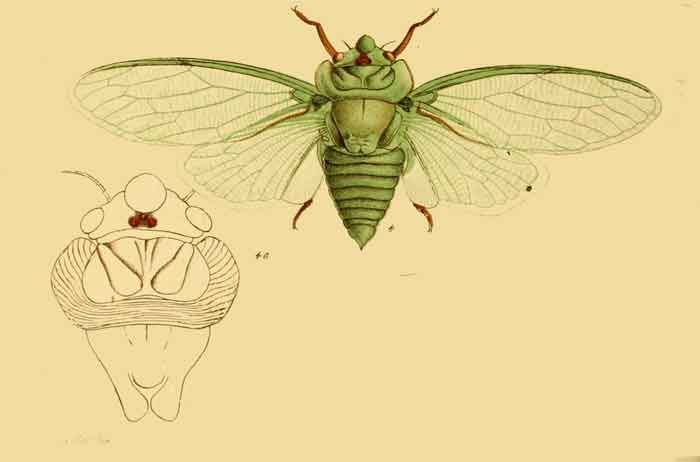
Cyclochila australasiae (*)
Superregnum: Eukaryota
Supergroup: Unikonta
Cladus: Opisthokonta
Cladus: Holozoa
Regnum: Animalia
Subregnum: Eumetazoa
Cladus: Bilateria
Cladus: Nephrozoa
Cladus: Protostomia
Cladus: Ecdysozoa
Cladus: Panarthropoda
Phylum: Arthropoda
Subphylum: Hexapoda
Classis: Insecta
Cladus: Dicondylia
Subclassis: Pterygota
Cladus: Metapterygota
Infraclassis: Neoptera
Cladus: Eumetabola
Cladus: Paraneoptera
Superordo: Condylognatha
Ordo: Hemiptera
Subordo: Auchenorrhyncha
Infraordo: Cicadomorpha
Superfamilia: Cicadoidea
Familia: Cicadidae
Subfamilia: Cicadinae
Tribus: Cyclochilini
Genus: Cyclochila
Species: Cyclochila australasiae
Name
Cyclochila australasiae
Vernacular names
English: Greengrocer cicada, yellow monday, green monday

Cyclochila australasiae, commonly known as the green grocer, is a species of cicada and one of Australia's most familiar insects. It is distributed through coastal regions of southeastern Australia.[1] It is one of the loudest insects in the world.[2]
Taxonomy
Cyclochila australasiae was formerly commonly known as the Great Green Cicada; in addition, the various colour forms have different vernacular names, including Yellow Monday for a common yellow morph; Chocolate Soldier for a rare dark tan form; Blue Moon for a rare turquoise form; and Masked Devil for its red-orange form.[3] The names for the green and yellow forms have been recorded since at least 1896.[3] Walter Wilson Froggatt reported that the green form was known as green Monday (alongside yellow Monday for the yellow form) in his 1907 work Australian Insects.[4]
The species was first described by amateur zoologist Edward Donovan as Tettigonia australasiae in 1805, while Ernst Friedrich Germar named it Cicada olivacea in 1830.[5]
Description
Cyclochila australasiae measures about 4 cm (1.6 in) in length, with a wingspan of 11–13 cm (4–5 in). Diverse colour forms are seen, the most common being predominantly green or brownish yellow. It has red eyes. The exuvia, or discarded empty exoskeleton of the nymph form, is commonly seen on tree trunks in gardens and bushland during the summer months.[1]
The loud calls of the male are heard over the summer months; harsh and high-pitched, these may reach 120 decibels.[6] The sound is made by the rapid buckling of the timbal ribs, and amplified by resonation in an air sac; the frequency is around 4.3 kHz.[7] Calls occur in the afternoon and dusk of warm days.[3]
Distribution and habitat
Cyclochila australasiae is found from Kroombit Tops in southeastern Queensland through eastern New South Wales and Victoria to the Grampians, and through to Mount Gambier in southeastern South Australia. It is common along the Great Dividing Range, and is also found in the Warrumbungles. It is commonly seen (and heard) around Sydney and Melbourne, the Blue Mountains and Gippsland. In Brisbane, it is only encountered at elevations above 300 m (1000 ft).[8] It was associated with the white stringybark (Eucalyptus globoidea) in a study at three sites in western Sydney.[9]
Life cycle
A Green grocer cicada molting
A Green grocer cicada drying its wings
Their median total life cycle length is around six to seven years, this being from egg to a natural adult death.[10] Most of this spent as a nymph. The cicada spends seven years in nymph form drinking sap from plant roots underground before emerging from the earth as an adult. The adults, who live for six weeks, fly around, mate, and breed over the summer.[3]
In popular culture
Live cicadas are often collected by climbing trees and can be kept temporarily as pets in shoeboxes. They cannot easily be kept for longer than a day or two, given that they need flowing sap for food.[11]
The Green grocer cicada is now the topic of a popular Australian children's book, "Cecil Singer Cicada" (Michelle Cox) released in January 2020.
The lifecycle of the Cicada was also referenced in the children’s book Cicada (2018) by Shaun Tan.
The Yellow Monday form is referenced in Clive James' epic poem "The River in the Sky" (2018).
References
Hangay G, German P (2000). Insects of Australia. Frenchs Forest, NSW: New Holland Press. pp. 58–59. ISBN 1-876334-41-X.
"Cicadas". Australian Museum. Archived from the original on 2007-12-17. Retrieved 2007-12-05.
"Greengrocer, Yellow Monday Fact File". Australian Museum online - Wildlife of Sydney. Australian Museum. 2009. Archived from the original on October 30, 2009. Retrieved 2009-04-03.
Froggatt, Walter Wilson (1907). Australian Insects. Sydney, New South Wales: W. Brooks. p. 349.
[1][permanent dead link]
"Cicadas: Superfamily Cicadoidea". Retrieved 2019-12-08.
Gerhardt HC, Huber F (2002). Acoustic communication in insects and anurans: common problems and diverse solutions. Chicago: University of Chicago Press. p. 33. ISBN 0-226-28832-3.
Moulds, Maxwell Sydney (1990). Australian Cicadas. Kensington, NSW: New South Wales University Press. pp. 61–65. ISBN 0-86840-139-0.
Emery, D.L.; Emery, S.J.; Emery, N.J.; Popple, L.W. (2005). "A phenological study of the cicadas (Hemiptera: Cicadidae) in western Sydney, New South Wales, with notes on plant associations". Australian Entomologist. 32: 97–110.
Campbell, Matthew (18 August 2015). "Genome expansion via lineage splitting and genome reduction in the cicada endosymbiont Hodgkinia - Supporting Information" (PDF). Proceedings of the National Academy of Sciences of the United States of America. 112 (33): 10192–10199. doi:10.1073/pnas.1421386112. PMC 4547289. PMID 26286984. Retrieved 13 October 2020.
Craig, Owen (17 February 2001). "Summer of singing cicadas". ABC Science – Environment and Nature. Australian Broadcasting Corporation. Retrieved 15 August 2013.
Retrieved from "http://en.wikipedia.org/"
All text is available under the terms of the GNU Free Documentation License

